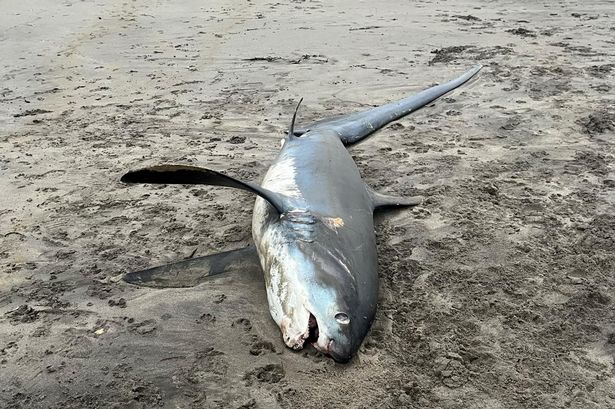The discovery of a deceased large thresher shark on Par Beach in Cornwall has sparked both sadness and scientific curiosity. This uncommon event, with the species typically inhabiting deeper offshore waters, has prompted the Cornwall Wildlife Trust to initiate a thorough post-mortem examination to ascertain the cause of death. The examination, more accurately termed a necropsy in the case of animals, will involve a detailed internal and external examination of the shark, analyzing its organs, tissues, and overall condition to uncover any potential clues. While the specific reasons behind the stranding remain unknown, various possibilities are being considered, ranging from natural causes such as disease or old age to anthropogenic factors like entanglement in fishing gear or collision with vessels. The incident underscores the vulnerability of marine life, even apex predators like the thresher shark, to both natural and human-induced threats within their ocean environment.
Thresher sharks, known for their exceptionally long caudal fins, which they use to stun prey, are not commonly encountered near shore. Their presence in shallower coastal waters, particularly in a deceased state, raises several questions about the circumstances leading to the stranding. The autopsy, conducted by marine biology experts, will involve a systematic examination of the shark’s body. This will include assessing its external condition for any signs of trauma, such as entanglement marks, propeller wounds, or parasitic infestations. Internally, the examination will focus on the health of its organs, checking for signs of disease, infection, or the presence of any foreign objects ingested. Tissue samples will likely be collected for further analysis, including microscopic examination and potentially toxicological testing to identify any contaminants or toxins that may have contributed to the shark’s demise. The information gleaned from the necropsy will not only shed light on this individual’s fate but also contribute to the wider understanding of thresher shark ecology and the challenges they face in the marine environment.
The significance of this event extends beyond the immediate investigation into the individual shark’s death. The findings from the autopsy will contribute valuable data to ongoing research efforts focused on marine wildlife health and conservation. By understanding the factors that lead to strandings and mortalities, scientists can develop more effective strategies to protect these vulnerable species. The data collected from this case will be added to existing databases, allowing researchers to track trends and patterns in shark strandings, which can inform conservation management decisions. For instance, if the necropsy reveals entanglement as the cause of death, it will strengthen the case for implementing measures to reduce bycatch in fisheries. Similarly, if disease is identified, it could highlight the need for further research into marine wildlife health, particularly emerging diseases that may be impacting shark populations.
The stranding of the thresher shark also serves as a poignant reminder of the interconnectedness of marine ecosystems and the impact of human activities on marine life. While natural causes can certainly lead to such events, the increasing pressures on ocean ecosystems from human activities, such as fishing, pollution, and climate change, cannot be ignored. The autopsy results may provide direct evidence of human impact or, conversely, rule out such factors and point towards natural causes. Regardless of the outcome, this incident highlights the importance of ongoing monitoring and research to understand the challenges facing marine species and the need for collaborative efforts to mitigate these threats. This includes promoting sustainable fishing practices, reducing pollution, and addressing climate change to ensure a healthy ocean for future generations.
The Cornwall Wildlife Trust plays a crucial role in marine conservation efforts in the region. They are dedicated to protecting and conserving the rich biodiversity of Cornish waters and coastlines. Their involvement in this case, from responding to the stranding to organizing the necropsy, demonstrates their commitment to understanding and addressing threats to marine life. The Trust also plays a vital role in educating the public about marine conservation issues and encouraging responsible behavior towards the environment. By raising awareness about the importance of marine ecosystems and the challenges faced by species like the thresher shark, they empower individuals to contribute to conservation efforts. This includes reporting sightings of stranded or injured marine animals, participating in beach cleans, and supporting sustainable seafood choices.
In conclusion, the discovery of the deceased thresher shark on Par Beach is a significant event that has prompted a thorough investigation by the Cornwall Wildlife Trust. The necropsy will provide valuable insights into the cause of death and contribute to broader research on marine wildlife health and conservation. While the specific reasons behind the stranding remain to be determined, this incident serves as a stark reminder of the vulnerability of marine life and the importance of continued efforts to protect our oceans. The work of organizations like the Cornwall Wildlife Trust is crucial in this endeavor, highlighting the need for ongoing research, monitoring, and public engagement to ensure the health and resilience of marine ecosystems. The information gathered from this case will ultimately help inform management strategies and conservation efforts aimed at protecting thresher sharks and other marine species from similar fates in the future.














